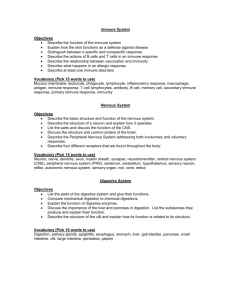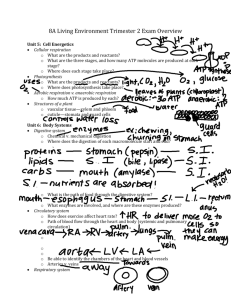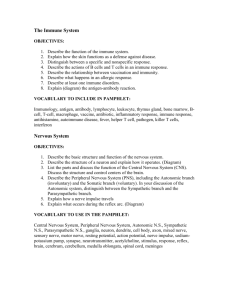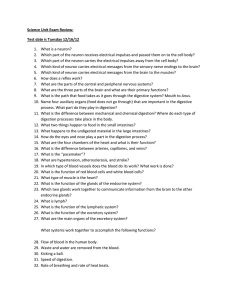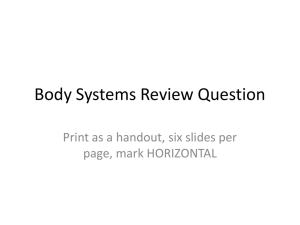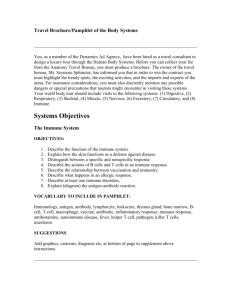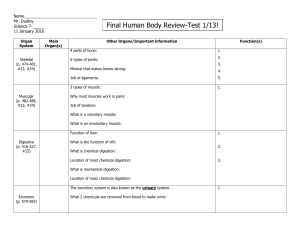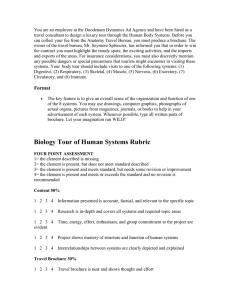Due Friday, May 16th
advertisement
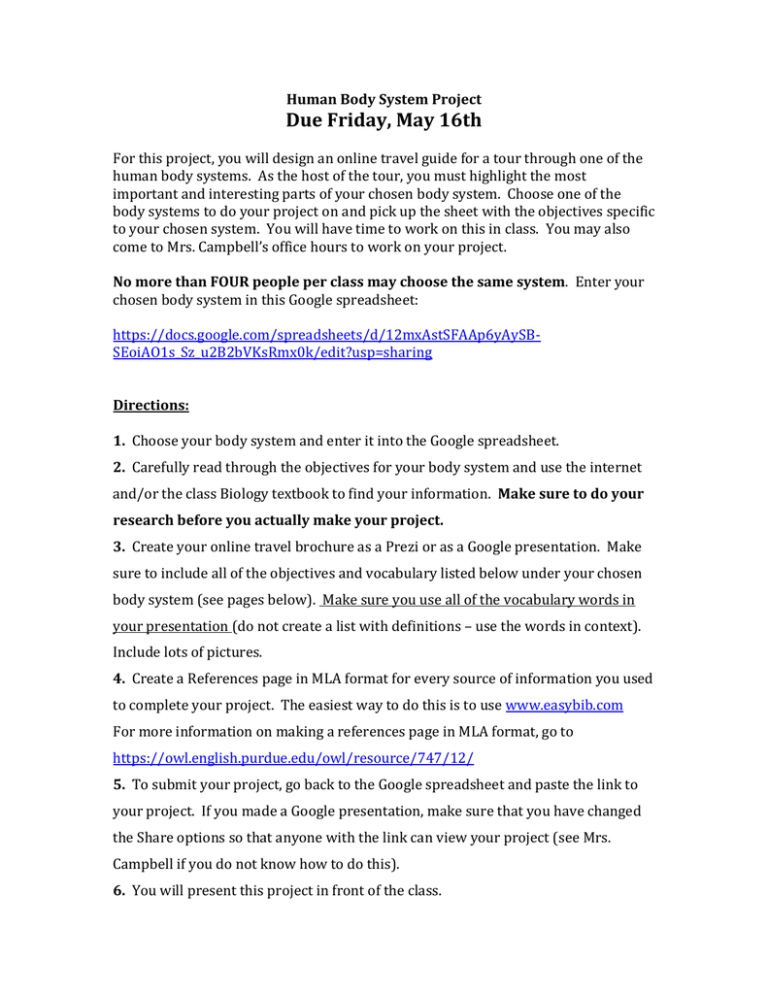
Human Body System Project Due Friday, May 16th For this project, you will design an online travel guide for a tour through one of the human body systems. As the host of the tour, you must highlight the most important and interesting parts of your chosen body system. Choose one of the body systems to do your project on and pick up the sheet with the objectives specific to your chosen system. You will have time to work on this in class. You may also come to Mrs. Campbell’s office hours to work on your project. No more than FOUR people per class may choose the same system. Enter your chosen body system in this Google spreadsheet: https://docs.google.com/spreadsheets/d/12mxAstSFAAp6yAySBSEoiAO1s_Sz_u2B2bVKsRmx0k/edit?usp=sharing Directions: 1. Choose your body system and enter it into the Google spreadsheet. 2. Carefully read through the objectives for your body system and use the internet and/or the class Biology textbook to find your information. Make sure to do your research before you actually make your project. 3. Create your online travel brochure as a Prezi or as a Google presentation. Make sure to include all of the objectives and vocabulary listed below under your chosen body system (see pages below). Make sure you use all of the vocabulary words in your presentation (do not create a list with definitions – use the words in context). Include lots of pictures. 4. Create a References page in MLA format for every source of information you used to complete your project. The easiest way to do this is to use www.easybib.com For more information on making a references page in MLA format, go to https://owl.english.purdue.edu/owl/resource/747/12/ 5. To submit your project, go back to the Google spreadsheet and paste the link to your project. If you made a Google presentation, make sure that you have changed the Share options so that anyone with the link can view your project (see Mrs. Campbell if you do not know how to do this). 6. You will present this project in front of the class. OBJECTIVES The Circulatory System 1. List the functions of the human circulatory system. 2. Locate and label the parts of the heart on a diagram. 3. Trace a drop of blood through the heart from the right atrium to the aorta. 4. Compare the blood in the right side of the heart to the blood in the left side of the heart. 5. Describe the components of blood: red blood cells, white blood cells, platelets, and plasma. 6. Identify and describe the functions of the two different types of circulation: pulmonary and systemic circulation. 7. Explain how the heart beats. 8. Explain what blood pressure is 9. Explain how blood is produced in the body. Describe the role of the spleen and bone marrow. 10. Discuss diseases of the heart (hypertension and atherosclerosis) Vocabulary that must be included in your project: Aorta, artery, atrium, capillary, circulatory system, coronary circulation, deoxygenated blood, diastolic, hemoglobin, pacemaker, plasma, platelets, pulmonary circulation, red blood cells, sphygmomanometer, systemic circulation, systolic, valve, vein, vena cava, ventricle, white blood cells. Immune System OBJECTIVES 1. Describe the function of the immune system. 2. Explain how the skin functions as a defense against disease. 3. Distinguish between specific and non-specific response. 4. Describe the actions of B cells and T cells in a immune response. 5. Describe the relationship between vaccination and immunity. 6. Describe what happens in an allergic response. 7. Describe at least one immune disorder (autoimmune disease). 8. Explain (diagram) the antigen-antibody reaction. Vocabulary that must be included in your project: Antigen, antibiotic, antibody, B-cell, bone marrow, immune response, inflammatory response, lymphocyte, leukocyte, macrophage, T-cell, thymus gland, vaccine. Digestive System OBJECTIVES 1. List the parts of the digestive system and give their functions. 2. Compare mechanical digestion to chemical digestion. 3. Explain the functions of the digestive enzymes amylase, protease, and lipase. 4. Explain the results of the chemical digestion of carbohydrates, proteins, and fats, and discuss where each digestion occurs – in the mouth, stomach, or small intestine. 5. Discuss the importance of the liver and pancreas in digestion. List the substances they produce and explain their function. 6. Describe the structure of the villi and explain how its function is related to its structure. 7. Explain what happens if someone has pyloric stenosis. Vocabulary that must be included in your project: Acidic pH, alimentary canal, amylase, bile, digestion, duodenum, E. coli, epiglottis, esophagus, feces, gall bladder, hydrochloric acid, large intestines, lipase, liver, mesentery, mucous, pancreas, pepsin, peristalsis, pyloric sphincter valve, rectum, salivary glands, small intestines, stomach, villi Respiratory System OBJECTIVES 1. Identify the structure and function of the parts of the respiratory system. 2. Explain the function of the ribs and diaphragm in the process of breathing. 3. Explain how breathing rate is controlled. 4. Describe what happens between the alveoli and the capillaries. 5. Discuss at least two diseases or disorders that affect the respiratory system. Vocabulary that must be included in your project: Alveoli, bronchi, cilia, CPR, diaphragm, epiglottis, exhalation, gas exchange, inhalation, larynx, lung, pharynx, pleural membrane, respiration, trachea Skeletal System OBJECTIVES 1. Identify twenty major bones in the body. 2. State the functions of the skeletal system. 3. Describe the composition of bone (what bone is made of ). 4. Explain the differences in the structure and function of the 4 major kinds of moveable joints – ball and socket, hinge, pivot, and gliding. 5. Discuss at least 2 injuries or disorders of the skeletal system. Vocabulary that must be included in your project: Appendicular skeleton, arthritis, axial skeleton, bursa, cartilage, endoskeleton, fontanels, Haversian canals, joints, ligaments, marrow, ossification, osteology, periosteum, synovial fluid, tendons Muscular System OBJECTIVES 1. Compare the structure and function of the three types of muscle tissue and give examples of where these muscles would be found in the body. 2. Explain how muscles contract. 3. Explain the function of flexors and extensors. 4. Explain how muscles fatigue. 5. Explain the relationships between muscles, bones, and tendons. 6. Explain the “all or none” response. 7. Identify 10 major muscles in the body. Vocabulary that must be included in your project: Acetylcholine, actin, cardiac muscle, cholinesterase, extensor, fatigue, flexor, ligament, muscle fiber, myofibril, myology, myosin, skeletal muscle, smooth muscle, tendon Nervous System OBJECTIVES 1. Explain the basic structure and function of the nervous system. 2. Diagram the structure of a neuron and explain how it operates. 3. List the parts of and discuss the function of the Central Nervous System (CNS). Discuss the structure and control centers of the brain. 4. Describe the Peripheral Nervous System (PNS), including the Autonomic branch (involuntary) and the Somatic branch (voluntary). In your discussion of the Autonomic system, explain the differences between the Sympathetic branch and the Parasympathetic branch. 5. Explain how a nerve impulse travels. 6. Explain and diagram what happens during the reflex arc. Vocabulary that must be included in your project: Acetylcholine, action potential, autonomic, axon, brain, cell body, central, cerebellum, dendrite, medulla oblongata, mixed neuron, motor neuron, nerve impulse, neuron, neurotransmitter, parasympathetic, peripheral, reflex, response, resting potential, sensory nerve, sodium-potassium pump, spinal cord, stimulus, sympathetic, synapse. Excretory System OBJECTIVES 1. Define excretion. 2. Describe the function of the skin, kidneys, lungs, and liver in the excretory process. 3. Describe the structure and function of the kidney and its parts. 4. Explain how the nephron functions. 5. Explain the difference between filtration and reabsorption. 6. Describe one disorder of the excretory system (such as a kidney disease). Vocabulary that must be included in your project: Aorta, active transport, adrenal glands, bladder, Bowman’s capsule, excretion, filtration, glomerulus, kidney, metabolic wastes, nephron, reabsorption, renal artery, renal vein, sweat glands, ureter, urethra, urine

